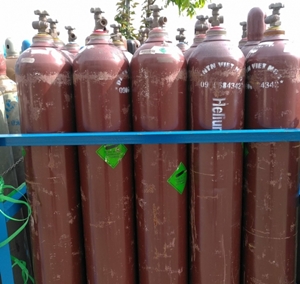
Since 2016, Viet Nga has been a trusted supplier of a diverse range of gases and industrial gas solutions, including helium.
1. Properties of helium
Helium has the lowest boiling point of all elements and can only solidify under extremely high pressure. It is typically a monatomic gas and chemically inert.
2. Prevalence of helium
Helium is the second most abundant element in the universe after hydrogen. In Earth’s atmosphere, its volumetric density is approximately 5.2 × 10⁻⁶ at sea level and gradually increases up to an altitude of 24 km, mainly because most atmospheric helium escapes into outer space due to its low density and chemical inertness.
A layer in the atmosphere at around 1,000 km altitude consists primarily of helium, though the overall pressure is extremely low.
In the Earth’s crust, helium ranks as the 71st most abundant element, comprising approximately 8 × 10⁻⁹, and in seawater it exists only at 4 × 10⁻¹². Helium is generally formed via radioactive decay of elements and can be found in uranium and thorium-bearing mineral deposits, in certain mineral waters, volcanic emissions, and various natural gas reservoirs.

3. Applications
Aerostatics: Helium is used to fill weather balloons and small airships due to its lower density compared to air.
Cryogenic cooling: Helium serves as a cryogenic liquid for superconducting magnets.
Nuclear energy: Due to its inertness, high thermal conductivity, neutron transparency, and non-radioactive nature under reactor conditions, helium is used as a heat-transfer medium in gas-cooled nuclear reactors.
Helium-3 research: Helium-3, abundant in the solar wind but deflected by Earth’s magnetic field, is being studied for potential lunar extraction as a promising energy source.
Voice pitch alteration: Helium, being significantly lighter than air, increases the speed of sound to approximately 927 m/s. Inhalation temporarily raises voice pitch, creating the well-known “chipmunk effect,” which is short-lived due to the low helium content in balloons.
Metal welding: Helium is used as a shielding gas in metal welding techniques such as TIG welding.
Superfluidity research: In 1930, cooling liquid helium to 2 K (-271.15°C) caused it to transition into superfluid helium with unique properties, such as creeping along surfaces and defying gravity due to zero viscosity.
Refrigeration technology: Helium mixed with heavier gases like xenon is used in cryogenic cooling systems due to high thermal power ratios and low Prandtl numbers, offering environmental advantages over conventional refrigerants.
Electronics: Helium is used in hard disk drives to reduce drag and heat generation.
For high-quality helium gas and other industrial gases at competitive prices, contact Viet Nga today for expert consultation and reliable supply solutions.



Create a free Listing to introduce your business and be visible to your potential customers
_________________________________
YELLOW PAGES CONTACT
+84 24.3636.9512 (Ext 312)
Hotline/ Zalo: +84 914 261 828 (Ms Amy)
